Phosphatidylinositol transfer protein, cytoplasmic 1 (PITPNC1) binds and transfers phosphatidic acid
- PMID: 22822086
- PMCID: PMC3442557
- DOI: 10.1074/jbc.M112.375840
Phosphatidylinositol transfer protein, cytoplasmic 1 (PITPNC1) binds and transfers phosphatidic acid
Abstract
Phosphatidylinositol transfer proteins (PITPs) are versatile proteins required for signal transduction and membrane traffic. The best characterized mammalian PITPs are the Class I PITPs, PITPα (PITPNA) and PITPβ (PITPNB), which are single domain proteins with a hydrophobic cavity that binds a phosphatidylinositol (PI) or phosphatidylcholine molecule. In this study, we report the lipid binding properties of an uncharacterized soluble PITP, phosphatidylinositol transfer protein, cytoplasmic 1 (PITPNC1) (alternative name, RdgBβ), of the Class II family. We show that the lipid binding properties of this protein are distinct to Class I PITPs because, besides PI, RdgBβ binds and transfers phosphatidic acid (PA) but hardly binds phosphatidylcholine. RdgBβ when purified from Escherichia coli is preloaded with PA and phosphatidylglycerol. When RdgBβ was incubated with permeabilized HL60 cells, phosphatidylglycerol was released, and PA and PI were now incorporated into RdgBβ. After an increase in PA levels following activation of endogenous phospholipase D or after addition of bacterial phospholipase D, binding of PA to RdgBβ was greater at the expense of PI binding. We propose that RdgBβ, when containing PA, regulates an effector protein or can facilitate lipid transfer between membrane compartments.
Figures

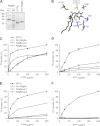

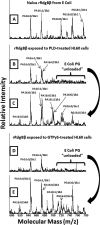

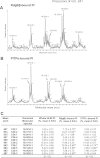

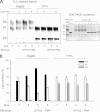
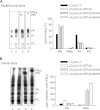

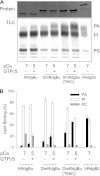


Similar articles
-
The phosphatidylinositol transfer protein RdgBβ binds 14-3-3 via its unstructured C-terminus, whereas its lipid-binding domain interacts with the integral membrane protein ATRAP (angiotensin II type I receptor-associated protein).Biochem J. 2011 Oct 1;439(1):97-111. doi: 10.1042/BJ20110649. Biochem J. 2011. PMID: 21728994
-
Potential role for phosphatidylinositol transfer protein (PITP) family in lipid transfer during phospholipase C signalling.Adv Biol Regul. 2013 Sep;53(3):280-91. doi: 10.1016/j.jbior.2013.07.007. Epub 2013 Jul 21. Adv Biol Regul. 2013. PMID: 23916246 Review.
-
The diverse functions of phosphatidylinositol transfer proteins.Curr Top Microbiol Immunol. 2012;362:185-208. doi: 10.1007/978-94-007-5025-8_9. Curr Top Microbiol Immunol. 2012. PMID: 23086419 Review.
-
14-3-3 protein and ATRAP bind to the soluble class IIB phosphatidylinositol transfer protein RdgBβ at distinct sites.Biochem Soc Trans. 2012 Apr;40(2):451-6. doi: 10.1042/BST20110770. Biochem Soc Trans. 2012. PMID: 22435829 Review.
-
RdgBα reciprocally transfers PA and PI at ER-PM contact sites to maintain PI(4,5)P2 homoeostasis during phospholipase C signalling in Drosophila photoreceptors.Biochem Soc Trans. 2016 Feb;44(1):286-92. doi: 10.1042/BST20150228. Biochem Soc Trans. 2016. PMID: 26862217 Review.
Cited by
-
Altered spawning seasons of Atlantic salmon broodstock transcriptionally and epigenetically influence cell cycle and lipid-mediated regulations in their offspring.PLoS One. 2025 Feb 24;20(2):e0317770. doi: 10.1371/journal.pone.0317770. eCollection 2025. PLoS One. 2025. PMID: 39992963 Free PMC article.
-
Lipid transfer proteins: the lipid commute via shuttles, bridges and tubes.Nat Rev Mol Cell Biol. 2019 Feb;20(2):85-101. doi: 10.1038/s41580-018-0071-5. Nat Rev Mol Cell Biol. 2019. PMID: 30337668 Review.
-
Control of metastatic progression by microRNA regulatory networks.Nat Cell Biol. 2013 Jun;15(6):546-54. doi: 10.1038/ncb2769. Nat Cell Biol. 2013. PMID: 23728460 Free PMC article. Review.
-
Transcriptomic analysis of differentially expressed genes in leaves and roots of two alfalfa (Medicago sativa L.) cultivars with different salt tolerance.BMC Plant Biol. 2021 Oct 5;21(1):446. doi: 10.1186/s12870-021-03201-4. BMC Plant Biol. 2021. PMID: 34610811 Free PMC article.
-
Mitochondrial CDP-diacylglycerol synthase activity is due to the peripheral protein, TAMM41 and not due to the integral membrane protein, CDP-diacylglycerol synthase 1.Biochim Biophys Acta Mol Cell Biol Lipids. 2018 Mar;1863(3):284-298. doi: 10.1016/j.bbalip.2017.12.005. Epub 2017 Dec 16. Biochim Biophys Acta Mol Cell Biol Lipids. 2018. PMID: 29253589 Free PMC article.
References
-
- Cockcroft S., Garner K. (2011) Function of the phosphatidylinositol transfer protein gene family: is phosphatidylinositol transfer the mechanism of action? Crit. Rev. Biochem. Mol. Biol. 46, 89–117 - PubMed
-
- Allen-Baume V., Ségui B., Cockcroft S. (2002) Current thoughts on the phosphatidylinositol transfer protein family. FEBS Lett. 531, 74–80 - PubMed
-
- Yoder M. D., Thomas L. M., Tremblay J. M., Oliver R. L., Yarbrough L. R., Helmkamp G. M., Jr. (2001) Structure of a multifunctional protein. Mammalian phosphatidylinositol transfer protein complexed with phosphatidylcholine. J. Biol. Chem. 276, 9246–9252 - PubMed
-
- Tilley S. J., Skippen A., Murray-Rust J., Swigart P. M., Stewart A., Morgan C. P., Cockcroft S., McDonald N. Q. (2004) Structure-function analysis of human [corrected] phosphatidylinositol transfer protein α bound to phosphatidylinositol. Structure 12, 317–326 - PubMed
-
- Vordtriede P. B., Doan C. N., Tremblay J. M., Helmkamp G. M., Jr., Yoder M. D. (2005) Structure of PITPβ in complex with phosphatidylcholine: comparison of structure and lipid transfer to other PITP isoforms. Biochemistry 44, 14760–14771 - PubMed
Publication types
MeSH terms
Substances
Grants and funding
LinkOut - more resources
Full Text Sources
Molecular Biology Databases
Research Materials
Miscellaneous

